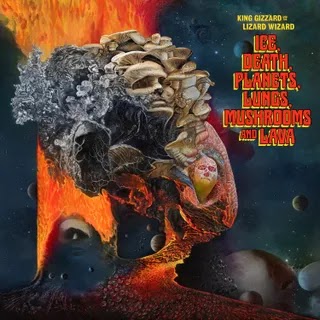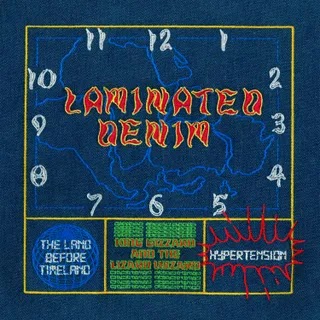The Gizzard’s abundant crop of fall albums spans custom incidental music, nerdy compositional experiments, and one of the best front-to-back records in their catalog.
Christmas came early this year for the Gizzhive. Beyond embarking on their first North American tour since the pandemic began, the ever-industrious King Gizzard & the Lizard Wizard gifted their faithful with three new records released over the course of four weeks this past October. These arrive a mere six months after the band’s most recent double album, which followed hot on the heels of another record, bringing their grand total of 2022 albums to five, matching the feat they first pulled off in 2017. At this point, being a King Gizzard fan is pretty much a full-time job.
You almost wonder if the Melbourne sextet is actively trying to corner the market: By displaying an equal facility with psychedelia, prog, garage-punk, jazz, kosmische musik, thrash metal, synth pop, and even rap, King Gizzard have essentially become the big-box one-stop for all your musical needs. And as anyone who’s braved Costco on a Saturday can tell you, an abundance of choice is liable to pull your attention in too many directions at once. The decision to unload a trio of records in near-tandem arguably does the greatest disservice to Ice, Death, Planets, Lungs, Mushrooms and Lava, which, if given more room to breathe as a standalone release, would more easily stick out as one of the best front-to-back records in the entire Gizzard catalog.
That may not seem obvious when you’re greeted by the album’s deceptively twee opener, “Mycelium,” a song so immersed in nerdy science-speak, it should come with a complementary head lamp. (Plenty of King Gizzard tunes make you want to take mushrooms; this one encourages you to study them, too.) But the song’s beach-bound vibe ultimately proves irresistible, its aquatic guitar lines, hiccuping reggae beats, and lustrous woodwinds enticing you to join the conga line even as main vocalists Stu Mackenzie and Ambrose Kenny-Smith start analyzing the more grotesque byproducts of human-fungi interactions. And “Mycelium” is a bellwether of more dramatic mutations to come, as Ice, Death, Planets, Lungs, Mushrooms and Lava stakes its claim as the band’s most agitated yet fiercely funky record. The album title may read like a word-cloud summary of the Gizzard’s favorite lyrical topics, but its songs chart new paths to the outer cosmos without leaning on the usual motorik thrusters.
The question of whether or not King Gizzard are a jam band has stuck to this group like the scent of patchouli on a hemp poncho, and Ice, Death justifies the claims of both the yea and nay camps. Certainly, this is one of their loosest, most sprawling records, with almost every track exceeding seven minutes; on the other hand, even the most outré odysseys are less a product of improvisation than intricate arrangement. When the Afrobeat-steeped “Ice V” and the dizzying 13-minute showstopper “Hell’s Itch” settle into their fleet-footed grooves and start introducing new ideas every 16 bars, the effect is less like a band showing off their chops and more like rotating MCs chiming in with a few rhymes on a posse cut. And where past Gizzard epics have embraced a racetrack construction, whipping in and out of recurring motifs at regular intervals, the mischievous “Magma” is built more like a spiral staircase, its guitar accents and frisky rhythms swirling skyward en route to the cataclysmic, wah-wah-splattered finale. Its sequel “Lava” works up to similarly awesome heights, then busts through the ash clouds to reveal a ray of hope. “The volcano is death, the lava is death/Death is life! The lava is life!” Mackenzie repeats with nursery-rhyme glee, summing up the cycle of life that undergirds King Gizzard’s usual apocalyptic premonitions: Our species may be fucked, but the planet will be reborn.
If Ice, Death is an exploratory record that sounds like it was made with little regard for time, Laminated Denim has its eye on the clock. The record comprises two extended pieces of exactly 15 minutes each—i.e., the precise length of the intermissions during the Gizzard’s three-hour sets at Red Rocks Amphitheater, where the tracks debuted over the PA on October 10 and 11. The intermission-soundtrack concept dates back to when those shows were first booked for May 2020, at which point the band recorded two works—the amorphous, electro-shocked instrumental “Timeland” and the cosmic-rock collage “Smoke & Mirrors”—for the occasion. After the concerts were postponed, the band released the unused pieces as this year’s Made in Timeland mini-LP. But once the Red Rocks dates were rescheduled for October, the band suddenly needed new intermission music. Enter Laminated Denim, an anagram of Made in Timeland that also reflects the musical relationship between the two records: Though they share the same temporal parameters, the contents within have been completely reimagined.
In contrast to Made in Timeland’s free-flowing techno doodles, Laminated Denim gives us two linear, conventionally structured, vocal-driven songs that carve out their own lane in the Gizzard discography, somewhere between the ceaseless propulsion of their signature strobe-lit rock-outs and the blissful melodicism that defines their occasional forays into pastoral whimsy. For much of its runtime, first track “The Land Before Timeland” casually choogles along like the Allman Brothers’ “Jessica” as produced by Conny Plank, setting its twinned-lead guitar noodling to a steady, vacuum-sealed drumbeat that stays locked in for the long haul. But no matter how far out it ventures, “The Land Before Timeland” never loses sight of its practical purpose as intermission music: The song comes equipped with a two-minute warning, turning darker and freakier in the home stretch as if to pressure the Red Rocks restroom crowd to piss faster and get back to their seats. The following “Hypertension” (pronounced by Mackenzie as “hyper-ten-shee-yun” in perfectly Liamesque fashion) builds off that unsettled mood, introducing itself as a more restless “Street Spirit” and sustaining that agitated energy for its entire run, culminating in an ascending staccato guitar solo that plays like the climax to “Marquee Moon” at warp speed. Even when removed from their site-specific function, the two pieces on Laminated Denim stay true to their original mission: They each make 15 minutes go by in a breeze.
The group’s final October offering, Changes, is likewise an attempt to revive a previously shelved concept: in this case, a specific chord progression that recurs throughout all seven tracks in different contexts. The band reportedly began working on Changes during the high season of 2017, but never got around to finishing the album because there were always other albums to finish. The end result doesn’t quite resemble a painstaking magnum opus: Changes is the most subdued and modest record of the Gizzard’s October harvest. The album makes its most audacious statement with the 13-minute overture “Change,” which both introduces the woozy Wurlitzer motifs that appear throughout the record and plants seeds for the many forms they’ll take over its duration. Propelled by sun-kissed keyboard melodies, jazz-bar upright bass, and jaunty summertime-stroll backbeats, this constantly shapeshifting track taps into the Gizzard’s inner Steely Dan, imagining an alternate ’70s where Fagen and Becker appealed to acid-eating prog-heads instead of cocaine yuppies.
At times, the attempt to build new songs out of the same chord progression feels less like a bold challenge than a cheeky looky-here: Changes’ second track “Hate Dancin’” seems like it easily could’ve been absorbed into the multi-sectional sprawl of “Change,” as it simply adds a new vocal melody atop the established rhythm bed, organizing its predecessor’s mood-board disarray into a compact three-minute pop song. But on “Astroturf,” those common chords function as a springboard into a twitchy funk workout bolstered by sinister brass stabs—and just when you think Mackenzie is going to start shredding, the band drops in a truly badass flute solo instead. In “Gondii,” we’re treated to the album’s most radical recontextualization, as those familiar progressions get embedded into a synth-powered rocker that transports us far beyond the album’s retro-’70s soul-jazz milieu. “Gondii” is named for the highly transmittable parasite commonly found in cats that, in extreme cases, can cause brain damage in humans and trick rodents into cozying up to their feline predators. In the album’s most inspired moments, the recurring refrains heard on Changes function in a similar way, subtly worming their way into the songs and causing the host to behave in unexpected ways.





0 comments:
Post a Comment